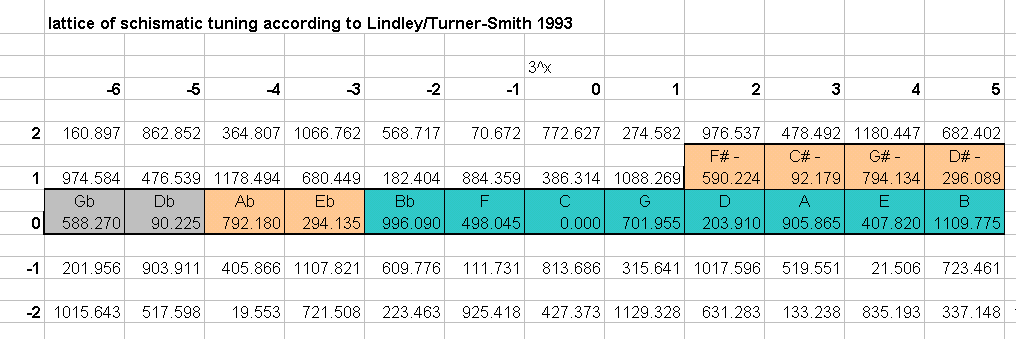According to Mark Lindley (Lindley/Turner-Smith 1993), from the evidence of musical usage in manuscripts of compositions, during the late 1300s and early 1400s composers began writing for keyboards tuned in a Pythagorean chain in which the notes tuned as Gb:Db:Ab:Eb were actually used often as F#:C#:G#:D#.
This tuning, called "Quasi-Pythagorean" by Lindley and dubbed "schismatic tuning" by other modern tuning theorists, assumes the equivalence of notes tuned a skhisma apart. Since this is only ~2 cents and therefore below the threshold of normal manual tuning error, these schismatic pairs of notes may indeed be assumed to be equivalent for all intents and purposes.
Below is a lattice of this tuning:
here is the scale as it was tuned, in a Pythagorean chain:
note 3^x ~cents
(Gb)/"F#" -6 588.2699948
(Db)/"C#" -5 90.22499567
Ab/"G#" -4 792.1799965
Eb/"D#" -3 294.1349974
Bb -2 996.0899983
F -1 498.0449991
C 0 0
G 1 701.9550009
D 2 203.9100017
A 3 905.8650026
E 4 407.8200035
B 5 1109.775004
the scale was tuned 3^(-6 ... +5), but Lindley says
that Gb and Db were not in use at this time, so that's
why i put them in parentheses.
here it is in descending order of pitch, as a chromatic scale:
note 3^x ~cents
B 5 1109.775
Bb -2 996.090
A 3 905.865
Ab/"G#" -4 792.180
G 1 701.955
(Gb)/"F#" -6 588.270
F -1 498.045
E 4 407.820
Eb/"D#" -3 294.135
D 2 203.910
(Db)/"C#" -5 90.225
C 0 0.000

Updated:
2003.03.23 -- page created
by Joe Monzo